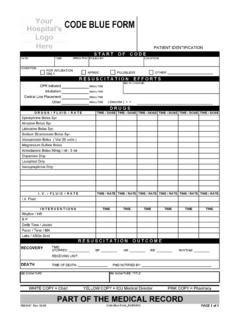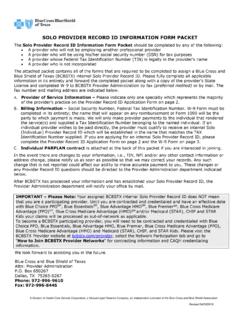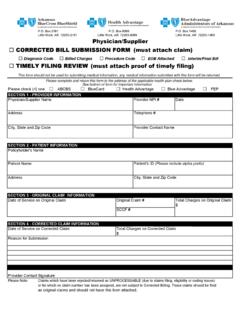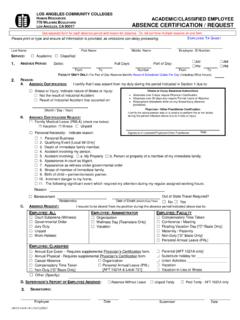Transcription of Code Blue Response-Self Instructional Module - gch.org
1 Implementing the ABCD s During a code blue Response in an Adult Patient self - Instructional Module Objectives 1. List the components of SBAR 2. Recognize the process for initiating a Rapid Response 3. Describe the process for initiating a code blue Response 4. Define the responders responsibilities during a code blue 5. Identify ACLS medications that may be utilized during a code blue 6. Indicate the equipment that may be utilized during a code blue 7. Explain documentation guidelines during and after a code blue 8. Describe end of code blue care 9. Discuss post resuscitation care 10. Participate in crash cart review session 11. Interpret 6 basic EKG rhythms Purpose This self learning Module is designed for the purpose of increasing nurses understanding of code blue Response by outlining accountabilities and practices related to staff, equipment, and processes pertaining to code blue issues.
2 Scope Registered Nurses and Licensed Practical Nurses. Activity This educational activity has multiple components: self Instructional Module with written exam Crash Cart and monitor/defibrillator review session offered on each unit and validated by the unit educator. Completion of this component includes: Participation in crash cart review Demonstrate use of Likepak monitor/defibrillator Demonstration of telemetry application EKG rhythm identification written exam and evaluation Thank you SKaras/2007 SBAR SBAR is a situational briefing tool that logically organizes information so it can be transferred to others in an accurate and efficient manner. SBAR fosters critical thinking and eliminates information from getting lost in translation. S Situation (why are you calling) B Background (why is the patient in the hospital) A Assessment (your impression of the situation) R Recommendation (suggestions you may have) Initiating a Rapid Response Rapid Response is a dedicated group of individuals that responds to emergency situations within the hospital in order to try to decrease mortality and morbidity on our patients.
3 The Rapid Responders: Intervene in a potential code /emergency situation Rely on bedside nurses who are highly sensitive to signs that a patient s condition is deteriorating, and empowered to call others to action. Notification Criteria Respiratory Rate >10 or <24 Wet lungs Shortness of breath Respiratory distress Heart rate persistently > 120 Heart rate <40 Arrhythmia Priority 1 & 2 alarms (described in Housewide Telemetry protocol) Systolic Blood Pressure <90 mmHg Mean Arterial Pressure (MAP) < 60 mmHg Chest Pain Mental Status Change Anxiety/Agitation Seizures Urine Output <30ml/hr X 2 hours Activation of Rapid Response Staff indicates criteria to activate Rapid Response Staff calls 3333 (operator) and states, Rapid Response needed in room number ___ Operator activates code pagers with message 1111 Patient s room number Assigned Rapid Responders will report to patient room SKaras/2007 Who are the Rapid Responders?
4 Registered Nurse (Critical Care Services staff nurse, Clinical Nurse Manager or Charge Nurse, Nursing Supervisor) Respiratory Therapist Designated Intern Roles and Responsibilities Rapid Response Registered Nurse o Arrive with tool kit o Function as a team leader in the absence of physician o Remain at bedside until patient is stabilized or transferred to appropriate level of care o Follow up visits 4 hours after the call for all patients not transferred to the ICU/CCU or 2C/N o Document on Rapid Response documentation form Respiratory Therapist o Arrive with tool kit o Function as part of the team regarding respiratory issues Intern o Team leader Bedside Nurse o Obtain manual vital signs o Print labs o Glucometer at bedside o Provide current situation/medical background of patient o Remain at bedside to care for patient Unit Secretary o Dial 3333 and state, Rapid Response needed in room number ___ o Print Rapid Response Progress note Rapid Response in not used in Lieu of.
5 code blue procedure for cardiopulmonary arrest Formal or informal critical care consult when indicated Perform routine admission, discharge, transfer, transport functions or IV start Exclusions to the Program Emergency Department ICU/CCU Operating Room PACU OB/Nursery with the exception of Post-Partum SKaras/2007 Initiating a code blue code blue refers to a patient in cardiac arrest, respiratory arrest, or any emergency situation that require resuscitation and intervention. Patient survival and positive outcomes depend on rapid assessment of the situation and initiation of basic and advanced life support measures. The first person to recognize that a patient has arrested should: Call for help from team members Dial 3333 and state code blue on _____ (nursing unit) or delegate someone to call a code . The code will be announced overhead and a message will be sent to all designated pagers.
6 Begin CPR immediately Staff members will assist by: Obtaining crash cart/defibrillator and immediately bring to the patient s bedside Place backboard under the patient as soon as possible to provide a hard, level surface for chest compressions thus will increase cardiac output Retrieve ambu bag, which is located in the RED box on bottom of the crash cart and provide ventilations Apply electrodes and lead wires to patients chest as follows: RA electrode (white) is applied to the right shoulder close to the junction of the right arm and torso. LA electrode (black) is applied to the left shoulder close to the junction of the left arm and torso. LL electrode (red) is applied below the heart in the abdominal region. Monitor patient and EKG tracing Placement of #18 or #20 gauge IV catheter may be necessary. If a central line is required, the kit is located in the 3rd drawer of the crash cart.
7 Barrier devices are located in the supply pyxis and/or drawer 3 of the crash cart: sterile towels and gloves face shields, gowns, and cap. SKaras/2007 Responders Director of the code : All house staff that is near the site of the code blue shall respond. Physician staff may be dismissed from the code blue scene after the physician in charge is determined. The physician in charge must be clearly identified as being in charge. Responsibilities include: Direct all activities of the resuscitation effort Delegate or directly participate in airway management, vascular access, medication orders, and maintaining Advanced Cardiac Life Support (ACLS) interventions Recording Nurse: The nurse assigned to the patient should be the person that documents all the events of the code for reasons of continuity in documentation and ability to provide information regarding the patients hospitalization, current treatments, medications and the events that occurred immediately before the code .
8 The recording nurse is responsible for: Ensuring the patient chart is brought to the room when the code is called Utilizing the Resuscitation Record to document events of the resuscitation effort, and assists with utilization of the Crash Cart including medication and IV preparation Place the completed Resuscitation Record in the chart. Progress notes should indicate patient condition prior to resuscitation code call . If necessary a late entry describing patient condition prior to the resuscitation event should be recorded. A notation must be made in the progress notes referring to the Resuscitation Record for events of the resuscitation Ensuring the family and physician has been contacted Transport patient to Critical Care Unit Medication Nurse: This hands on nurse is responsible for: Initiating BLS-HCP measures according to American Heart Association (AHA) standards Provide ACLS measures Initiate cardiac monitoring Locate/apply quick-comb redi-pak that can be utilized for defibrillation, cardioversion, transcutaneous pacing, and viewing the cardiac rhythm.
9 Assess for patent IV and/or assist with the initiation of IV route Prepare, label and administer medications per physician order Assemble equipment for intubation and suctioning Respiratory Therapist: Three respiratory care staff is assigned each shift to respond to code blue . Respiratory Therapists responsibilities include: Perform BLS-HCP according to AHA standards Maintain airway by suctioning and manual ventilation before intubation Assist physician with intubation and securing endotracheal tube (ETT) Obtaining blood sample for arterial blood gas analysis SKaras/2007 Set up oxygen and ventilation equipment Assist with transport to critical care unit Ensure proper paperwork is completed for the Respiratory Care Department Anesthesiologist: If the physician is unable to intubate the patient, the operator may page an anesthesiologist (call 3375 to confirm an anesthesiologist was contacted) to intubate the patient, ensure an adequate airway and to facilitate ventilation.
10 Unit Secretary: The unit secretary must remain at the nurse s station to contact the appropriate personnel upon request, place orders in the computer, and answer the telephone. Charge Nurse/Nursing Supervisor: The supervising nurse acts as a resource facilitator for the code team. The resource facilitator is responsible for: Communicating with personnel regarding equipment and ancillary service needs. Coordination of the initial resuscitation effort, assisting the recording and medication nurse Checking on and removing any other patients or visitors in the room as necessary Making space for the resuscitation effort Clearing unnecessary staff from the room Those who are not listed as team members and who are not actively participating in the resuscitation effort. Coordinating the transfer effort by contacting Registrar and/or ICU/CCU to facilitate transfer of the patient after resuscitation.




